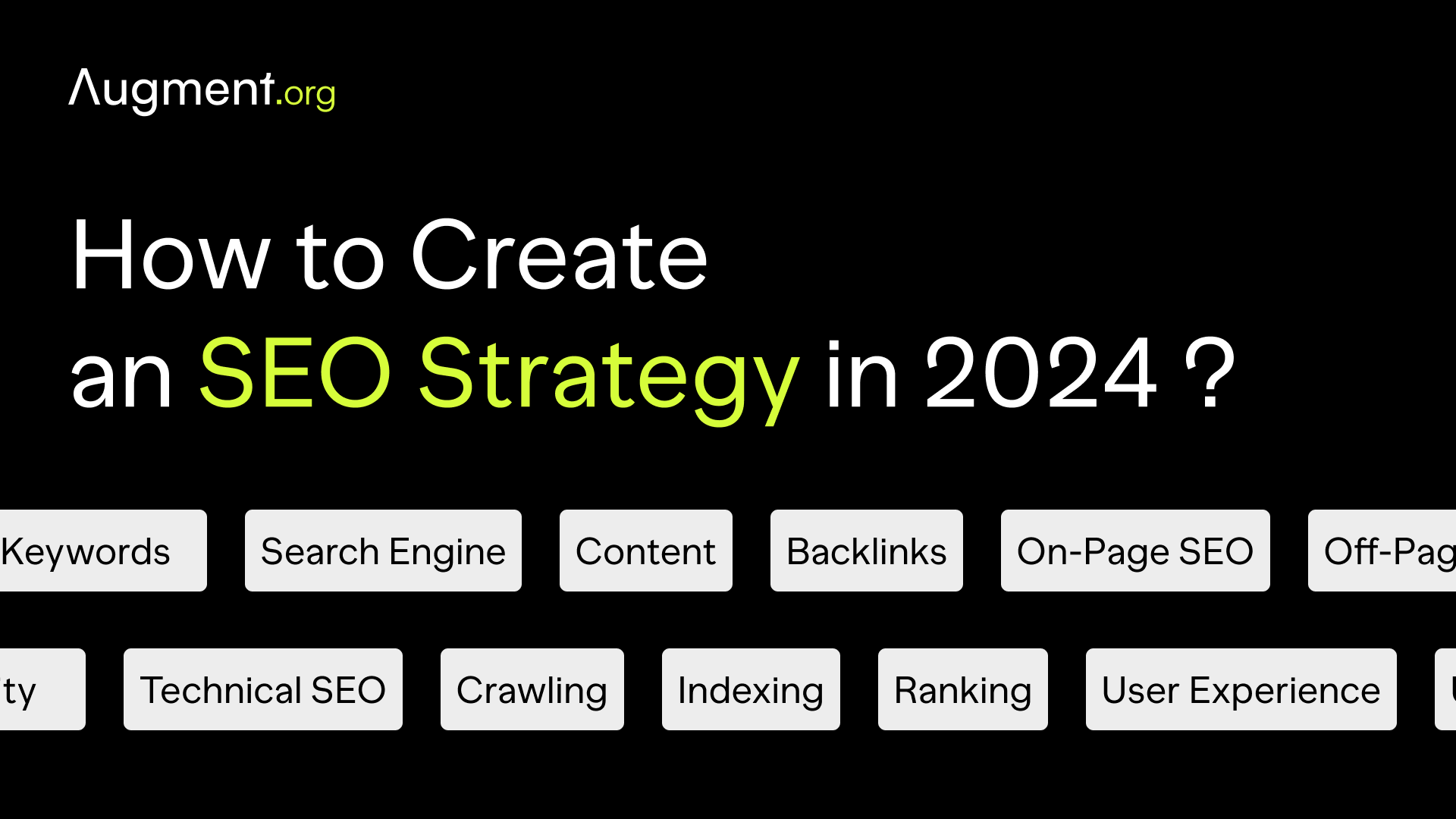SEO Content Strategy: How to Create an SEO Strategy for 2024
Understanding SEO content strategy is crucial for driving organic traffic to your web pages. Learn how to develop an effective strategy that enhances your content marketing and propels your digital presence.

What is SEO Content?
SEO content is a blend of creativity and technical precision, designed to cater to both search engines and your target audience. At its core, SEO content is any form of content created with the goal of attracting search engine traffic. This isn't just about stuffing keywords into web pages; it's about crafting content that answers the search intent of users while being optimized for search engines.
It involves a balance of keyword research, understanding search engine algorithms, and creating content that is informative, engaging, and relevant. The essence of SEO content lies in its ability to not just draw organic traffic, but also to hold the attention of the reader, turning visitors into loyal followers or customers.
This type of content can take various forms, from blog posts and articles to infographics and videos. Each piece is meticulously crafted with the right keywords to ensure it ranks well in search results. However, the focus isn't solely on keywords; the content must also provide value, offering insights, solutions, or information that resonates with your target audience.
SEO content is the art of combining content marketing with search engine optimization strategies to create content that is both discoverable and valuable to your target market.
Why is an SEO Content Strategy Important?
An effective SEO content strategy is fundamental in today's digital landscape. It's not just about creating content, but about crafting it in a way that aligns with how search engines work and what your target audience seeks. This strategy is critical for several key reasons:
- Driving Organic Traffic: By optimizing content for search engines, you increase the chances of your web pages appearing higher in search results. This visibility is vital for attracting organic traffic, which is often more engaged and convertible than traffic from other sources.
- Meeting Target Audience Needs: SEO content strategy goes beyond just keyword research. It involves understanding the search intent behind those keywords, ensuring that your content addresses the questions, needs, and pain points of your audience. This relevance is what turns visitors into loyal followers or customers.
- Building Credibility and Authority: When your content consistently appears in search results, it helps establish your brand as an authoritative source in your field. This credibility can lead to more backlinks from other websites, further boosting your SEO efforts.
- Long-Term Digital Marketing Success: Unlike paid advertising, the benefits of a well-executed SEO strategy are long-lasting. Quality content that ranks well can continue to drive traffic and generate leads for years, offering an excellent return on investment.
An SEO content strategy is not just about pleasing search engines. It's about creating a sustainable approach to digital marketing that resonates with your audience, builds your brand’s authority, and drives ongoing organic traffic.
What are the Elements of an SEO Strategy?
A successful SEO strategy is a composite of several key elements that work together to enhance your online visibility and reach. These elements include:
- Keyword Research: The cornerstone of any SEO strategy. It involves identifying the terms and phrases (keywords) that your target audience is searching for. This process helps in understanding search intent and tailoring your content to meet those needs.
- Content Creation: The heart of SEO. High-quality, relevant content is essential for engaging your audience and answering their queries. Whether it's a blog post, a long-form article, or a video, the content should provide value and be aligned with your SEO goals.
- On-Page SEO: This involves optimizing individual web pages to rank higher in search engines. It includes optimizing page titles, headings, content, and internal links with the right keywords.
- Off-Page SEO: This relates to external factors that impact your site's ranking, like backlinks from other websites. Effective off-page SEO involves strategies like link building and social media marketing to boost your site's authority and credibility.
- Technical SEO: Ensuring your website is structured and coded in a way that search engines can easily crawl and index. This includes aspects like mobile optimization, fast loading times, and secure connections (HTTPS).
- User Experience (UX): A vital but often overlooked component. A good UX keeps visitors on your site longer, reducing bounce rates and signaling to search engines that your site is valuable.
- Analytics and Performance Tracking: Regularly monitoring your website's performance using SEO tools and analytics is crucial. This data helps you understand how your content is performing and where adjustments are needed.
An effective SEO strategy is a blend of technical know-how, creative content creation, and continuous optimization. Each element plays a critical role in ensuring that your content not only reaches your target audience but also fulfills their needs and expectations.
5 Steps to Create an SEO Strategy
Creating an effective SEO strategy is a multifaceted process. Here are the key steps, each of which plays a crucial role in crafting a winning SEO content strategy.
1. Find Topics with Search Traffic Potential
Analyze Search Queries and Keywords
To uncover what your target audience is searching for, dive into keyword research using tools like Google Keyword Planner or SEMrush. Start by inputting broad topics related to your industry. These tools will generate a list of related keywords, including high traffic keywords and long-tail keywords. Long-tail keywords, while less competitive, can be incredibly valuable as they often have a clear search intent and can drive more qualified traffic.
Pay attention to the search volume and competition level of these keywords. Also, explore related keywords and phrases that might not be immediately obvious but are still relevant to your audience. This step is crucial in understanding the language and search habits of your potential customers, aligning your content with their needs.
Study Competitor Content
Researching your competitors’ content can provide valuable insights into what topics are resonating with your target audience. Use tools like BuzzSumo to see which articles in your industry are getting the most shares and engagement. Look at your competitors' blogs, social media posts, and the most visited pages on their websites.
Analyze the type of content that is performing well for them - whether it's how-to guides, listicles, case studies, or thought leadership pieces. Identify gaps in their content that you could fill or topics that you could cover in more depth or from a new angle. This approach will help you create content that not only competes but stands out in your industry.
Leverage Social Media Platforms
Social media platforms are a goldmine for topic ideas. They offer real-time insights into what your target audience is interested in and discussing. Monitor hashtags, follow industry influencers, and participate in relevant groups and forums. Tools like Social Mention can help you track what's being said about certain topics or keywords across different social platforms.
Pay attention to the questions people are asking and the problems they're looking to solve. This can inspire content that directly addresses these issues, increasing its relevance and shareability. Additionally, engaging with your audience on these platforms can provide direct feedback and ideas for future content.
Consider Audience’s Pain Points
Understanding your audience's pain points is key to creating content that resonates and provides value. Conduct surveys, interviews, or use tools like Answer The Public to find out what challenges your target audience faces. Forums and Q&A sites like Quora can also be helpful to see what questions people are asking in your industry.
Develop content that offers solutions, advice, and insights into these pain points. This not only helps in building trust with your audience but also positions your brand as a thought leader in your industry. Remember, content that effectively addresses the pain points of your target market is more likely to generate organic traffic and engagement.
2. Choose the Right Format for Your SEO Content
Blog Posts and Articles
Long-form articles are a cornerstone of SEO content strategy. They provide the space for an in-depth exploration of topics, which is ideal for incorporating a variety of relevant keywords and long-tail phrases. This depth of content allows for comprehensive coverage of a subject, increasing the likelihood of satisfying search queries fully.
Longer content also tends to keep readers engaged for more time on your page, a factor that search engines may consider as a sign of quality and relevance. When creating blog posts or articles, focus on delivering value through well-researched, informative, and engaging content. Ensure that these pieces are structured with clear headings and subheadings (including keywords where appropriate) and include internal links to other relevant content on your site.
Infographics and Visual Content
Infographics and other visual content formats, such as charts or interactive graphics, are highly shareable and can significantly boost engagement. They present information in an easily digestible format, making complex data or concepts more understandable. This shareability leads to increased backlinks and social media shares, which are beneficial for SEO.
To optimize visual content for search engines, include descriptive titles and alt text with relevant keywords. Also, accompany these visuals with a text summary or article to ensure search engines can fully understand and index the content.
Videos
Videos are becoming increasingly important in SEO content strategies. They are favored by search engines, especially for queries that benefit from visual or practical demonstrations, like tutorials or product reviews. Videos keep users engaged longer on your pages and can be a powerful tool for conveying information that might be too complex or lengthy for text.
To optimize videos for SEO, use descriptive titles and meta descriptions, include a transcript or summary with relevant keywords, and host them on platforms like YouTube for additional visibility.
Pillar Pages and Guides
Pillar pages and comprehensive guides are formats that allow you to establish authority in your field. These are extensive, detailed pages covering a broad topic in depth, linking out to more specific, related content (cluster content). This structure not only helps users navigate your site and find relevant information easily but also allows search engines to recognize your site as a valuable resource on particular subjects.
Pillar pages should be well-researched, covering all aspects of a topic, and regularly updated to ensure they remain current and comprehensive. Use keywords strategically throughout these pages, and make sure they are user-friendly with a clear, logical structure and navigation.
3. Integrate Keywords on Your Content Pages
Use Keywords in Titles and Headings
Incorporating your primary keyword into the page title and main headings is essential for SEO. The title of your page is the first thing search engines and users see, and it should accurately reflect the content of the page while including the primary keyword. This not only helps with search engine indexing but also improves click-through rates from search engine result pages.
Similarly, use keywords in your headings and subheadings to structure your content effectively. This practice makes your content easier to read and navigate, both for users and search engines. Remember to keep your titles and headings clear, concise, and enticing.
Sprinkle Keywords Throughout the Content
Strategically place your chosen keywords throughout the content, ensuring they appear naturally and contextually. The goal is to make your content relevant and searchable without compromising readability. Avoid keyword stuffing, which can lead to penalties from search engines and diminish the user experience.
Instead, focus on creating content that flows naturally while subtly incorporating keywords. Use synonyms and related terms to avoid repetition and to keep the content fresh and engaging. Remember, the primary aim is to provide value to your audience; the inclusion of keywords should enhance, not detract from this goal.
Optimize Meta Descriptions and URLs
Meta descriptions provide a summary of your webpage content and are a critical factor in user click-through rates from search results. Include your primary keyword in the meta description in a way that accurately represents the content of the page. This helps search engines understand the relevance of your page to specific search queries.
URLs should be concise, readable, and include your primary keyword. A well-structured URL can provide search engines and users with a clear indication of the page's content, aiding in better indexing and usability.
Utilize Internal Links
Internal linking is a powerful SEO tactic. By linking to other relevant content on your site, you guide users to additional information and increase the time they spend on your site. Use descriptive anchor texts that include relevant keywords for these internal links. This not only helps with SEO but also improves user experience by providing them with easy access to related content.
Internal linking also helps search engines understand the structure of your site and the relevance of pages to specific keywords, which can positively influence your site ranks in search results. Remember to link contextually and avoid overloading your content with links.
4. Create a Content Calendar
Plan Topics in Advance
Creating a content calendar starts with planning topics in advance. This process involves outlining the subjects you intend to cover over the next few months, aligning them with your SEO content strategy. Utilize the insights gained from your keyword and topic research to select themes that are not only relevant to your target audience but also have the potential to rank well in search engines. When selecting topics, consider seasonality, industry events, and any major company milestones that may influence content relevance.
This proactive approach allows you to strategically structure your content to align with user interests and search trends, ensuring a steady flow of fresh, relevant content on your website and social media platforms.
Set a Consistent Publishing Schedule
Consistency is key in content marketing. Determine a publishing frequency that is sustainable for your team and beneficial for your SEO efforts. This could be daily, weekly, or bi-weekly posts, depending on your resources and the nature of your content.
Stick to this schedule as closely as possible, as consistency helps build audience expectation and loyalty, and it signals to search engines that your site is regularly updated with fresh content. Use tools like editorial calendars or scheduling software to plan and track your publishing timeline. This structure helps in maintaining a balanced and varied content mix, ensuring that your audience stays engaged and informed.
Allocate Resources
Effective content creation requires the allocation of adequate resources. Break down the content creation process into tasks such as research, writing, editing, graphic design, and publishing. Assign these tasks to team members based on their skills and expertise, ensuring each piece of content is crafted to a high standard. Set realistic deadlines for each stage of the process to manage workflow and avoid bottlenecks.
This step is crucial in ensuring that content is not only produced on time but also meets quality standards. Regular meetings or check-ins can help keep everyone on track and address any challenges that arise.
Review and Adjust Regularly
A content calendar should be a dynamic tool. Regularly review and adjust your content plan based on performance data and emerging trends. Use analytics tools to track the performance of your content in terms of engagement, traffic, and conversions. Analyze what types of content are resonating with your audience and which ones are underperforming. Be prepared to shift your strategy in response to these insights or to external factors like changes in market trends or Google's algorithm updates.
This flexibility allows you to continuously optimize your content strategy, ensuring that your efforts are aligned with your SEO goals and audience needs. Remember, a successful content calendar is one that evolves with your audience and the digital landscape.
5. How to Analyze Your Content Performance
Use Analytics Tools
Leveraging tools like Google Analytics is crucial for understanding your content's performance. These tools provide a wealth of data on traffic, engagement, and conversion rates. Start by setting up goals in Google Analytics to track specific actions you want users to take on your site, like signing up for a newsletter or making a purchase. Regularly check your traffic sources to understand where your visitors are coming from, whether it's organic search, social media, or referral links.
Analyze page views and unique visitors to gauge the popularity of your content. Also, look at the average time spent on each page and the overall bounce rate to assess user engagement. This data helps in identifying what types of content are most effective and where improvements can be made.
Track Rankings for Your Keywords
Monitoring your search rankings for targeted keywords is essential in evaluating your SEO content strategy's effectiveness. Use tools like Google Search Console or SEMrush to track how your pages rank for specific keywords over time. Pay attention to changes in rankings and investigate potential causes, such as algorithm updates or increased competition.
This tracking can help you understand which pieces of content are performing well and which ones need optimization. It’s also useful for identifying opportunities for targeting new keywords or updating existing content to maintain or improve rankings.
Evaluate Engagement Metrics
Engagement metrics offer insights into how your audience interacts with your content. Time on page indicates how long visitors are staying on your content, which can be a good indicator of its relevance and quality. A high bounce rate might suggest that the content is not meeting the expectations of visitors or is not user-friendly.
Social shares are another crucial metric; they show how often your content is being shared on social media platforms, reflecting its popularity and shareability. Regularly reviewing these metrics helps you understand what resonates with your audience, allowing you to tailor future content to their preferences and interests.
Adjust Your Strategy
Based on the insights gathered from analytics and engagement metrics, adjust your content and SEO strategy accordingly. If certain types of content are consistently performing well, consider producing more on similar topics or in similar formats. Conversely, if some content is underperforming, analyze why and make necessary adjustments, which could be in the content itself, its promotion, or SEO optimization.
Use this data to guide your future content creation, focusing on what works best for your target audience and your SEO goals. Remember, an effective SEO strategy is flexible and adapts to changing trends and audience behaviors. Regular analysis and adjustments are key to a successful, long-term content marketing strategy.



